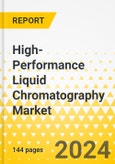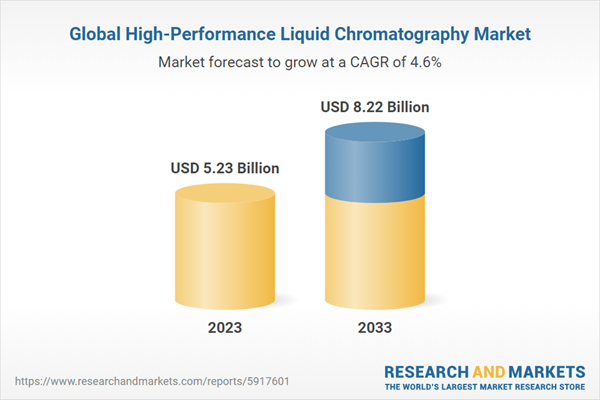This report comes with 10% free customization, enabling you to add data that meets your specific business needs.
Market Lifecycle Stage
The global HPLC market exhibits indications of decelerated growth, heightened competition, and saturation in key applications, signaling a shift toward maturity. It has not yet reached that stage. Continued technological innovations and market expansion in emerging regions continue to propel growth, placing it within the late maturity phase. While mature traits are evident, complete maturity has not been realized at present.Industry Impact
The HPLC market has a significant impact on the healthcare sector by offering vital tools for pharmaceutical research, drug development, and clinical diagnostics. HPLC ensures medication safety and efficacy by analyzing drug compounds and implementing quality control measures. In clinical settings, it aids in disease diagnosis, monitoring disease progression, and therapeutic drug monitoring. Additionally, HPLC supports biomedical research, enabling the study of intricate biological samples and contributing to advancements in precision medicine for tailored patient care.The global market for high-performance liquid chromatography (HPLC) demonstrates diverse regional impacts, influenced by factors such as healthcare infrastructure, regulatory frameworks, and cultural attitudes toward analytical techniques. In regions such as North America and Europe, where the market is well-established, there is a notable emphasis on advanced analytical methods, including HPLC and UHPLC. This emphasis has led to the widespread adoption of HPLC systems across various sectors, including clinical research and forensics. Additionally, the presence of robust healthcare systems and substantial investment in research and development further bolsters innovation in this field within these regions. On the other hand, the Asia-Pacific region has also been witnessing rapid market growth propelled by increasing awareness of technological advancements, expansion of healthcare facilities, and rising disposable incomes among consumers.
Market Segmentation:
Segmentation 1: by Product
- Instruments
- Consumables
- Accessories
Instruments to Dominate the Global High-Performance Liquid Chromatography Market (by Product)
The instrument segment dominated the market with a 65.91% share in 2022 and is expected to retain its position during the forecast period 2023-2033. The segment forms the core of HPLC analysis and is primarily driven by the success of integrated HPLC systems.Segmentation 2: by Application
- Clinical Research
- Diagnostic
- Forensics
- Others
Clinical Research to Dominate the High-Performance Liquid Chromatography Market (by Application)
The global HPLC market (by application) has been broadly segmented into clinical research, diagnostic, forensics, and others. The market is dominated by clinical research, which held a share of 47.62% in 2022 and is projected to maintain its dominance during the forecast period.Segmentation 3: by Region
- North America
- Europe
- Asia-Pacific
- Latin America
- Middle East and Africa
Demand - Drivers, Restraints, and Opportunities
Market Drivers:
Rising Demand from the Pharmaceutical and Biotechnology Sectors: The escalating uptake of high-performance liquid chromatography (HPLC) within the pharmaceutical and biotechnology sectors stems from its indispensable utility in maintaining product integrity, facilitating drug development processes, and ensuring compliance with rigorous regulatory protocols. HPLC's ability to deliver precise analyses, accurate quantification, and superior resolution positions it as a cornerstone technology for tasks ranging from drug formulation optimization to impurity profiling and biopharmaceutical characterization. Moreover, ongoing innovations in HPLC technology, alongside heightened investment in research and development initiatives, underscore its status as an essential business asset, catering to the dynamic demands and standards prevalent within these thriving industries.Market Restraints
High Cost of HPLC systems: The high cost of HPLC systems can be a major obstacle to their development and accessibility, posing challenges for both healthcare industry. Beyond the initial investment, regular maintenance and calibration add hefty ongoing expenses. Tight budgets often struggle to accommodate these recurring costs, further restricting the utilization of advanced HPLC technologies.Market Opportunities
Integration with AI for Advanced Data Analysis and Interpretation: The incorporation of artificial intelligence (AI) into high-performance liquid chromatography (HPLC) signifies a groundbreaking advancement in data analysis. Through AI algorithms, HPLC systems streamline the interpretation of complex chromatographic data, allowing for real-time analysis, precise peak detection, and accurate compound identification. A biotechnology and bioengineering study revealed an AI-driven solution for automating chromatographic peak integration in the pharmaceutical sector, promising enhanced accuracy and efficiency. This innovation, executed under a Digital Innovation Management framework, holds potential benefits for the biopharmaceutical industry, including improved patient safety and cost reduction.How can this report add value to an organization?
Workflow/Innovation Strategy: The high-performance liquid chromatography market (by product type) has been segmented based on product type, including instruments, consumables, and accessories. Moreover, the study provides the reader with a detailed understanding of the different applications.Growth/Marketing Strategy: To foster growth in the global high-performance liquid chromatography market, businesses can concentrate on expanding into emerging regions and catering to specialized applications while innovating products. Utilizing digital marketing and forming partnerships with industry leaders can boost brand presence and market reach. Offering comprehensive training and superior customer service can foster client trust and loyalty. Continuous market analysis and adaptability to changing customer demands are crucial for long-term success.
Competitive Strategy: Key players in the global high-performance liquid chromatography market have been analyzed and profiled in the study, including manufacturers involved in new product launches, acquisitions, expansions, and strategic collaborations. Moreover, a detailed competitive benchmarking of the players operating in the global high-performance liquid chromatography market has been done to help the reader understand how players stack against each other, presenting a clear market landscape.
Methodology
Key Considerations and Assumptions in Market Engineering and Validation
- The base year considered for the calculation of the market size is 2022. The historical year analysis has been done from FY2020 to FY2021, and the market size has been calculated for FY2022 and projected for the period 2023-2033.
- The geographical distribution of the market revenue has been estimated to be the same as the company’s net revenue distribution. All the numbers have been adjusted to two digits after decimals for report presentation reasons. However, the real figures have been utilized for compound annual growth rate (CAGR) estimation. CAGR has been calculated from 2023 to 2033.
- The market has been mapped based on different types of products available in the market and several indications. All the key manufacturing companies that have a significant number of offerings to the high-performance liquid chromatography market have been considered and profiled in the report.
- In the study, the primary respondents' verification was considered to finalize the estimated market for the high-performance liquid chromatography market.
- The latest annual reports of each market player have been taken into consideration for market revenue calculation.
- Market strategies and developments of key players have been considered for the calculation of sub-segment split.
- The base currency considered for the market analysis is US$. Currencies other than the US$ have been converted to the US$ for all statistical calculations, considering the average conversion rate for that particular year. The currency conversion rate has been taken from the historical exchange rate of the Oanda website or from the annual reports of the respective company, if stated.
Primary Research
The key data points taken from primary sources include:
- validation and triangulation of all the numbers and graphs
- validation of report’s segmentation and key qualitative findings
- Understanding of the numbers of the various markets for market type
- Percentage split of individual markets for regional analysis
Secondary Research
Open Sources
- World Health Organization (WHO), PubMed, Medical Device Regulations (MDR), and Food and Drug Administration (FDA)
- Annual reports, SEC filings, and investor presentations of the leading market players
- Companies’ websites and detailed study of their portfolios
- Gold standard magazines, journals, whitepapers, press releases, and news articles
- Databases
The key data points taken from secondary sources include:
- Segmentations, split-ups, and percentage shares
- data for market value
- key industry trends of the top players of the market
- Qualitative insights into various aspects of the market, key trends, and emerging areas of innovation
- quantitative data for mathematical and statistical calculations
Key Market Players and Competition Synopsis
High-performance liquid chromatography (HPLC) is a fundamental technique in analytical chemistry utilized for the separation, identification, and quantification of components within mixtures. Functioning on chromatographic principles, HPLC involves the passage of a sample through a column containing a stationary phase material, causing separation based on chemical properties such as size, polarity, or charge. Its applications span various sectors, including pharmaceuticals, food and beverage, environmental analysis, forensics, and research. Key components of HPLC systems include a pump, injector, column, detector, and data system. Associated products include columns, solvents, standards, sample preparation kits, detector accessories, consumables, and software, which collectively enable researchers and analysts to characterize and quantify compounds with precision and sensitivity.Primary drivers behind this growth encompass technological strides in HPLC and its increasing integration into drug discovery and development endeavors, fueling the market expansion in turn. The superior sensitivity and precision of HPLC systems additionally bolster market momentum. Nonetheless, apprehensions regarding the steep costs associated with HPLC systems and the scarcity of proficient personnel may impede market growth. Nevertheless, the HPLC market is set to witness sustained expansion, buoyed by the imperative for analytical techniques amidst ongoing research and development initiatives within the domain.
Some of the prominent companies in this market are:
- Thermo Fisher Scientific, Inc.
- Merck KGaA
- Shimadzu Corporation
- Waters Corporation
- Agilent Technologies, Inc.
- Bio-Rad Laboratories, Inc.
- PerkinElmer, Inc.
- Hitachi, Ltd.
- YMC Co. Ltd.
- Restek Corporation
- Gilson, Inc.
- Phenomenex
This product will be delivered within 3-5 business days.
Table of Contents
Companies Mentioned
- Agilent Technologies, Inc.
- Thermo Fisher Scientific Inc.
- Bio-Rad Laboratories, Inc.
- Shimadzu Corporation
- Waters Corporation
- PerkinElmer Inc.
- Merck KGaA
- Hitachi, Ltd.
- YMC CO., LTD.
- Restek Corporation
- Gilson, Inc.
- Phenomenex, Inc.
- JASCO
- Orochem Technologies Inc.
Table Information
| Report Attribute | Details |
|---|---|
| No. of Pages | 144 |
| Published | March 2024 |
| Forecast Period | 2023 - 2033 |
| Estimated Market Value ( USD | $ 5.23 Billion |
| Forecasted Market Value ( USD | $ 8.22 Billion |
| Compound Annual Growth Rate | 4.6% |
| Regions Covered | Global |
| No. of Companies Mentioned | 14 |









